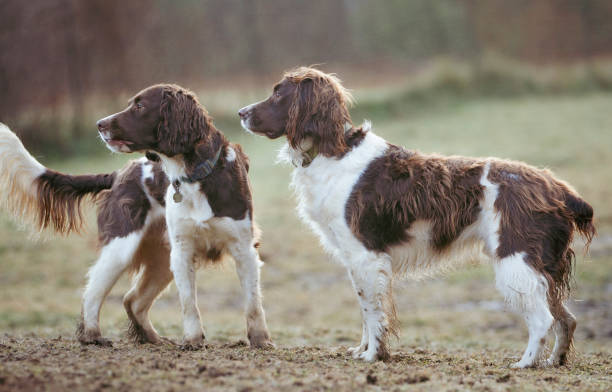Field Spaniel

Breed History:
The Field Spaniel originated in England in the mid-1800s and was originally developed for flushing game in fields and dense underbrush. It shares ancestry with the Cocker Spaniel and English Springer Spaniel but was bred to be larger and more versatile, with a darker coat ideal for camouflage in the field.
Unfortunately, early breeding for exaggerated traits nearly led to the breed’s decline by the early 20th century. Breeders later restored the Field Spaniel’s original functionality and form. Though still rare today, it is recognized by major kennel clubs and appreciated for its even temperament and utility.
|
Gender |
Height |
Weight |
|
Male |
46 cm |
18-25 kg |
|
Female |
43 cm |
16-22 kg |
Size – Medium
Life Expectancy: 12–13 years

Breed Appearance:
The Field Spaniel is a well-balanced, noble-looking dog with a solid, slightly longer-than-tall frame. It has a refined head, almond-shaped eyes with a gentle expression, and long, well-feathered ears that lie close to the cheeks.
Its single-layered coat is long, silky, and water-resistant, and typically comes in solid colors like liver, black, or roan, sometimes with tan points. The feathering on the chest, ears, undercarriage, and legs gives it an elegant yet functional appearance.
Breed Type – Sporting/Companion:
Originally bred for fieldwork, this spaniel is a capable hunting partner but also makes a devoted and affectionate companion. Field Spaniels are known for being gentle, intelligent, and sensitive, making them excellent for families and calm households.
They are typically friendly with people and other dogs, though slightly reserved with strangers. Their even disposition suits them well as therapy dogs and in canine sports.

Training:
Field Spaniels are intelligent and eager to please, which makes them relatively easy to train. However, they are also sensitive, so training should be gentle, patient, and reward-based.
They excel in obedience, rally, scent work, and agility. Early socialization and consistent reinforcement are important to prevent shyness or stubbornness.
Health & Care:
Field Spaniels are generally healthy but can be prone to the following conditions:
-
Ear infections (due to floppy ears)
-
Hip dysplasia
-
Eye problems (e.g., cataracts, retinal atrophy)
-
Hypothyroidism
-
Autoimmune disorders (rare but possible)
Regular veterinary care, a balanced diet, and appropriate exercise help maintain health. Responsible breeders screen for hereditary conditions.

Living Conditions:
Field Spaniels adapt well to households with a yard or apartment living if exercised adequately. They thrive in calm, loving environments and dislike being left alone for extended periods.
They are moderate-energy dogs indoors but enjoy opportunities to explore outdoors. A fenced yard is ideal for off-leash play.
Exercise:
These dogs need about 60–90 minutes of exercise per day, including walks, playtime, and mental challenges. They enjoy fetching, swimming, and scent work, making them excellent companions for active but not overly intense lifestyles.
They are not hyperactive but do need daily outlets to stay happy and well-behaved.
Grooming:
-
Moderate grooming needs
-
Brush 2–3 times per week to prevent tangles and mats
-
Trim feathering and ears regularly for neatness
-
Clean ears frequently to prevent infection
-
Bathe as needed, especially after outdoor activity
-
Routine nail trimming and dental care are essential
They shed moderately year-round.

Advantages:
-
Gentle, calm, and affectionate
-
Great with families and other pets
-
Intelligent and trainable
-
Versatile in both the field and home
-
Low barking tendency
-
Adaptable to various living conditions
Disadvantages:
-
Sensitive—responds poorly to harsh training
-
Can be reserved with strangers
-
Requires regular grooming and ear care
-
Prone to separation anxiety if left alone too long
-
Still relatively rare and hard to find
-
Needs consistent mental stimulation

